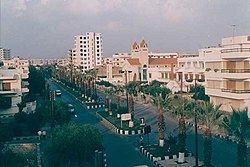Tartus
|
طرطوس / Ṭarṭūs Tartus |
||
|---|---|---|
|
|
||
| Coordinates | 34 ° 53 ' N , 35 ° 53' E | |
| Basic data | ||
| Country | Syria | |
| Tartus | ||
| ISO 3166-2 | SY-TA | |
| height | 20 m | |
| Residents | 97,557 (2010) | |
|
Hamrat Street in Tartus
|
||
Tartus ( Arabic طرطوس, DMG Ṭarṭūs ), in Roman times Antaradus , at the time of the Crusaders Tartosa or Tortosa ; is a city on the Mediterranean coast in Syria and the capital of the governorate of the same name .
The population was calculated to be 97,557 for 2010.
location
Tartus is the country's second largest port city after Latakia . It is located opposite the island of Arwad , about 90 kilometers south of Latakia and 65 kilometers north of Tripoli . The small fishing port is in the urban area, the larger main port one kilometer north in El Mina.
The Russian Navy maintains its only base in the Mediterranean at the Tartus naval base ; the facility has been used by the Soviet Union and Russia since 1971.
history
On the island of Arwad in front of the city and in the vicinity of the city there are traces of Phoenician settlements that date back to at least the 1st millennium BC. Go back BC. The founding of the city itself is attributed to the Crusaders . In 1102 Raimond de Saint Gilles , Count of Toulouse, seized the city's territory. To secure his conquests, he built a citadel. The city became an independent fiefdom within the fourth crusader state, the county of Tripoli .
In 1152 the city was conquered by Emir Nur ad-Din . He lost it to the crusaders under King of Jerusalem Baldwin III in 1155 . He handed the city over to the Knights Templar in 1157 .
The Knights Templar built the city into a massive fortress for the time, which Sultan Saladin besieged in 1188 without success. In the following period Tartus became more and more important for the Templars and was one of the most important fortifications of the order towards the end of the Crusader era. In August 1291, the Templars had to give up the fortress as their last base in Syria.
An attempt by the Knights Templar to restore the base, begun in 1300, failed due to a lack of further support in 1302 due to a counterattack by the Mamelukes . After the siege of Aruad in the same year, the last Crusader outpost on the Levant coast also disappeared .
In the centuries following the Crusades, Tartus no longer had any particular historical significance.
Attractions
- The Notre-Dame de Tortosa Cathedral is one of the most beautiful churches from the time of the Crusaders and built partly in Romanesque , partly in Gothic style. Today it serves as a museum.
- The Citadel of Tartus , built by the Templars in the late 12th and early 13th centuries, is now a residential area. Parts of the fortifications and the tower structures of the walls can still be seen.
- The island of Aruad is about 3 kilometers away and is a popular destination.
literature
- Frank Rainer Scheck, Johannes Odenthal: Syria. High cultures between the Mediterranean and the Arabian desert. 5th edition. DuMont, Ostfildern 2011, ISBN 978-3-7701-3978-1 , pp. 221-224.
- Thomas Biller: Templar castles. Darmstadt 2014. pp. 72–77.
Web links
Individual evidence
- ↑ Page no longer available , search in web archives:
- ↑ Syria, Russian naval cooperation grows. gulfnews.com, September 12, 2008



